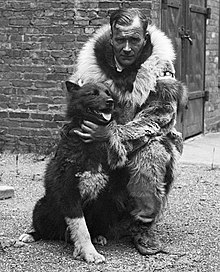Gunnar Kaasen
| Gunnar Kaasen | |
|---|---|

Gunnar Kaasen with his pet huskey, Balto
|
|
| Born |
March 11, 1882 Burfjord valley, Norway |
| Died | November 27, 1960 (aged 78) Everett, Washington, United States |
| Occupation | Musher |
Gunnar Kaasen (March 11, 1882 – November 27, 1960) was a Norwegian-born musher who delivered a cylinder containing 300,000 units of diphtheria antitoxin to Nome, Alaska, in 1925, as the last leg of a dog sled relay that saved the U.S. city from an epidemic.
Gunnar E. Kaasen was born the son of Hans and Anna Kaasen in Burfjorddalen, in Troms county, Norway. He went to the United States to mine for gold in 1903, in the wake of the discovery of gold-bearing sands on Cape Nome in 1898, which triggered one of several gold rushes in the state between 1891 and 1898. Kaasen became an experienced musher and a resident of Nome. While the boom was spent by 1905, the port of Nome sits on Norton Sound, which is usually ice locked and inaccessible by ship between October and June. Dog sledding remained the primary transportation and communication link to the outside world during the winter months.
In 1925, an outbreak of diphtheria threatened Kaasen's adopted home, and the disease could easily spread across the northern Alaska villages of which Nome was the hub. The Inuit children in particular had no immunity to the "white man's disease". The port was frozen. No train routes or regular roads extended to the northern coast of Alaska. Bush piloting was in its infancy; the only two aircraft in the state had open-cockpits, and had never been flown in the winter. Given the choices, Governor Scott Bone authorized the transport of 300,000 units of serum in Anchorage to Nenana by train, where it was picked up by the first of twenty mushers and more than one hundred dogs who relayed the serum the remaining 674 miles (1,085 km) to Nome. Kaasen was scheduled to transport the 20 pound (9 kg) cylinder of serum along the next-to-last leg of the relay, from Bluff to Point Safety, Alaska. At Bluff, Charlie Olson passed the serum to Kaasen, who left with a team of 13 dogs, led by the husky Balto. Kaasen traveled through the night, in the middle of winds so severe that his sled flipped over and he almost lost the cylinder containing the serum. Visibility was so poor he could not always see the dogs harnessed closest to the sled.
...
Wikipedia
